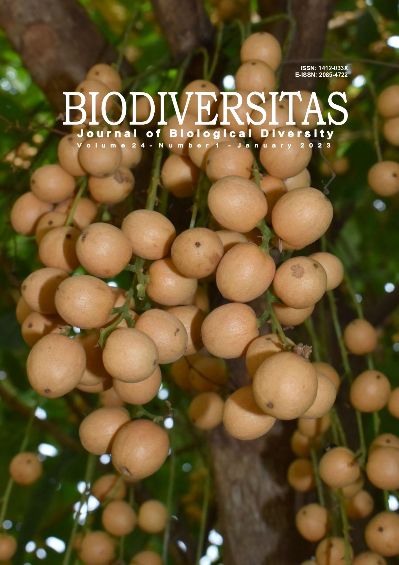Nutraceuticals and bioactive properties of local Java pigmented rice
##plugins.themes.bootstrap3.article.main##
Abstract
Abstract. Pradipta S, Siswoyo TA, Ubaidillah M. 2023. Nutraceuticals and bioactive properties of local Java pigmented rice. Biodiversitas 24: 571-582. Pigmented rice is used in nutraceuticals and has health benefits, on the other side, the characterization of local pigmented rice has not been widely observed. This research aimed to determine the nutraceutical and bioactive properties of ten pigmented Indonesian rice varieties (Segreg, Merah SP, Gogo Niti II, Mansur. Merah Wangi, MS Pendek, Super Manggis, Lamongan I, Aek Sibundong, and Seksek). The proximate composition of pigmented rice was performed based on standard methods. The antioxidant activity was carried out using DPPH radical scavenging activity. Morphological characteristics of these pigmented rice were the weight of 1000 grains ranges 17.47-23.10 g, with slender, medium, and bold shape categories. The proximate analysis revealed a significant difference (p<0.05) among cultivars, excluding the lipid. Amylose content varied between 17.43-25.71%. The lowest amylose cultivar had a high peak, trough, and final viscosities but a low pasting temperature. The gelatinization enthalpy was 0.83-1.93 J/g, and the thermal properties of the onset were between 78.6-83.60ºC. The peak was 81.90-86.20ºC, and the conclusion temperature was between 86.00-89.80ºC. The functional properties of the water absorption index were 5.1-7.42 g/g. The water solubility index was 2.32-7.32%, the oil absorption index was 0.92-1.67 g/g, and the bulk density was 0.56-0.70 g/cm3. The total phenolic range was 2.69-9.51 mg GAE/g, and flavonoids were between 0.61-2.31 mg QE/g. Antioxidant activity has been positively correlated with the percentage of flavonoids in phenolics.
##plugins.themes.bootstrap3.article.details##
Most read articles by the same author(s)
- HALIMATUS SA’DIYAH, MOHAMMAD UBAIDILLAH, YOGA DHEWA PRANATA HARIYADI, VEGA KARTIKA SARI, Screening of the antimicrobial activity of Indonesian banana (Musa spp.) against pathogenic bacteria , Biodiversitas Journal of Biological Diversity: Vol. 25 No. 4 (2024)
- AGUNG NUGRROHO PUSPITO, NOOR ROZZITA, MELLFANI RHAMADINDA NENDRA TIGARA, SATRIA ISKANDAR DINATA PUTRA, SRI HARTATIK, IKA PURNAMASARI, MOHAMMAD UBAIDILLAH, Molecular screening of local Indonesian rice to identified resistant varieties against brown planthopper (Nilaparvata lugens) attacks , Biodiversitas Journal of Biological Diversity: Vol. 24 No. 10 (2023)
- KACUNG HARIYONO, LULUK NOVIANA, MOHAMMAD UBAIDILLAH, AGUNG SIH KURNIANTO, ROSE NOVITA SARI HANDOKO, Genetic, phenotypic, and agronomic diversity of arrowroot (Maranta arundinacea) across agroclimatic zones for environmental adaptation and conservation , Biodiversitas Journal of Biological Diversity: Vol. 25 No. 10 (2024)
- GREGORIO QUINTAO, MOHAMMAD UBAIDILLAH, SRI HARTATIK, RENDRYANA AULIA NUR KHOFIFA, TRI AGUS SISWOYO, The morpho-physiological and gene expression of East Timor’s local rice plant (Oryza sativa) response to drought and salinity stress , Biodiversitas Journal of Biological Diversity: Vol. 24 No. 8 (2023)

